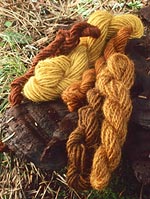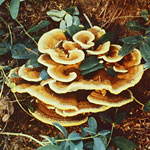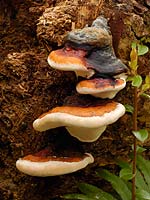SOMA's own Miriam C. Rice originally discovered in the 1970s that fungi could be used both for natural dyes and as substrate for making paper. These fungal art forms have now spread worldwide from their origins in nearby Mendocino County, and led to the creation of the International Mushroom Dye Institute. SOMA members Dorothy Beebee and Catherine Wesley now teach classes in dyes and papermaking at fungus fairs, SOMA Camp, and mushroom workshops.

Yarn dyed from Phaeolus schweinitzii. Photo © Marlene Nordstrom.

Phaeolus schweinitzii. Photo © Robert C. Beebee.
Mushroom dyes

Yarn dyed from Phaeolus schweinitzii. Photo © Marlene Nordstrom.

Phaeolus schweinitzii. Photo © Robert C. Beebee.
In the 1970s, Miriam discovered mushrooms contained pigments that could be used for natural dyes. Extracting these natural pigments turns out to be fairly simple: just chop up some mushrooms, cover them with water, and bring to a simmer. If the mushrooms contain any water-soluble pigment, it will immediately start to run in the hot water.
The dye color obtained depends on both the species and the mordants used for fixing the dye. In general, much of the pigment resides in the reproductive parts of the mushroom (i.e., gills, pores, tubes); mushrooms with white or pale reproductive parts tend to yield little color (but there are always exceptions). Some good local dye fungi include
- dyer's puffball (Pisolithus tinctorius)
- Paxillus atrotomentosus
- Phaeolus schweinitzii
Mordants are metallic salts commonly used by natural dyers to aid in the setting of a dye on fiber to make it lightfast and colorfast. Two recommended safe mordants are potassium alum and iron sulfate, which are available online from many fiber supply sources such as Dharma Trading Co.
Mushrooms may be used most successfully to dye protein fibers, such as wool, silk, and mohair (even alpaca and llama!), or the harder-to-dye cellulose fibers such as cotton, and hemp, resulting in lighter hues.
For more information on Mushroom Dyes at SOMA Camp, please contact the SOMA Mushroom Dye Coordinator.
Fungi for paper
Miriam also discovered that the detritus left over from the dyepot could be used to make paper! Always a passionate advocate of recycling, she found this to be a natural solution for disposal of the fungal residue of the dye process.
Shelf mushrooms called polypores typically make the best paper, likely because of their high chitin and cellulose content. Polypores are commonly found growing on trees or on dead logs, and can easily be collected year-round and dried for later use. Some good local paper polypores include
- artist's conk (Ganoderma applanatum)
- turkey tails (Trametes versicolor)
- red-belted conk (Fomitopsis pinicola)




